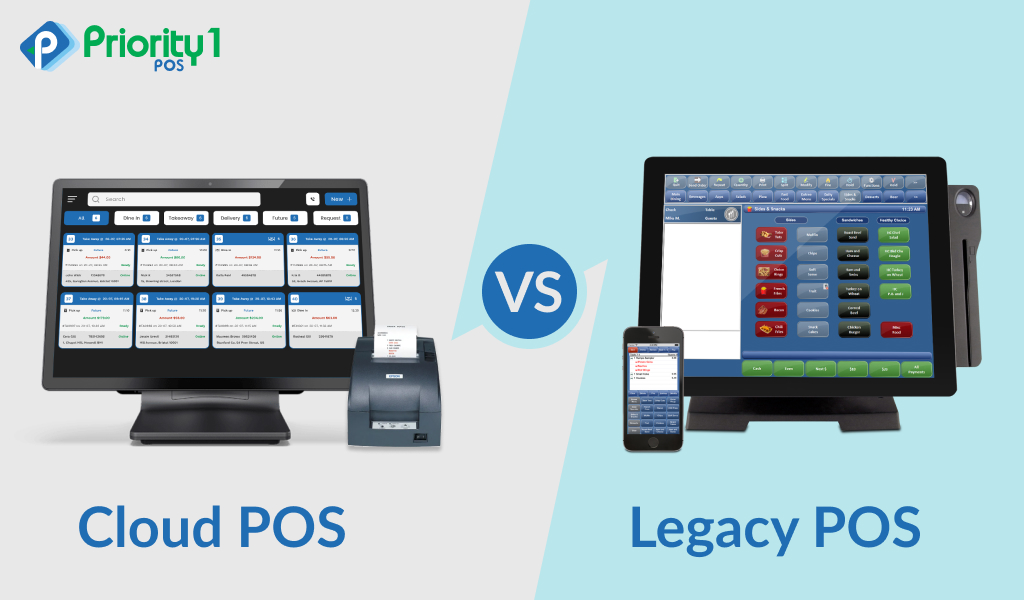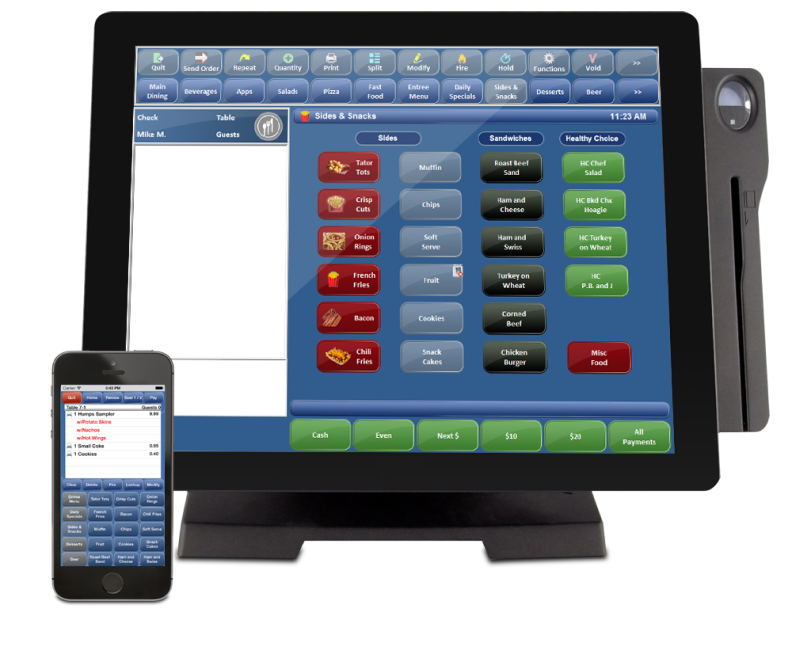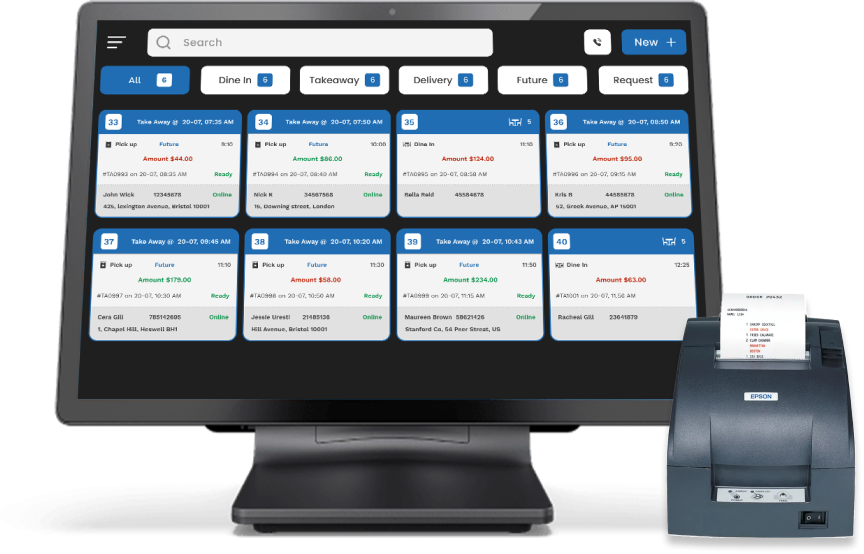
A Point of Sale (POS) system is a critical component in the operational framework of any restaurant, functioning as the central hub for transaction processing.
At its core, a POS system facilitates the sales process by allowing restaurants to handle transactions efficiently and accurately.
These systems are integral in recording sales, managing orders, and tracking inventory, thereby ensuring smooth operational workflows and an enhanced customer experience.
The importance of a POS system in the restaurant industry cannot be overstated. It streamlines the transaction process, reducing wait times and improving order accuracy.
This not only enhances customer satisfaction but also boosts the overall efficiency of the restaurant. Moreover, modern POS systems come equipped with advanced features for inventory management, employee scheduling, and generating comprehensive sales reports, all of which contribute to better decision-making and resource management.
The evolution of POS systems has been remarkable. Initially, restaurants relied on traditional cash registers that were limited to basic transaction processing.
These mechanical devices required manual input and offered no advanced functionalities. Over time, the need for more sophisticated solutions led to the development of digital POS systems, which introduced computer-based interfaces and basic software capabilities.
Today, POS systems have transformed into highly advanced digital solutions that leverage cloud technology, mobile connectivity, and integrated software applications. Cloud-based POS systems offer significant advantages such as real-time data access, remote management, and enhanced scalability.
They provide a seamless, integrated approach to handling transactions, managing orders, and analyzing sales data, thus empowering restaurant owners to operate more efficiently and effectively.
In conclusion, the adoption of modern POS systems is essential for any restaurant aiming to optimize its operations and enhance customer satisfaction.
As the industry continues to evolve, the choice between legacy and cloud-based POS systems becomes a critical decision, necessitating a comprehensive understanding of their respective advantages and limitations.
Overview of Legacy POS Systems

Legacy Point of Sale (POS) systems have been the cornerstone of restaurant operations for decades. These systems typically operate on a local server and involve dedicated terminals installed on-site.
The architecture of legacy POS systems is largely on-premises, meaning that all software and data are hosted and managed within the physical location of the restaurant. This setup was initially designed to handle the transactional and operational demands of high-volume food service environments.
The hardware components of legacy POS systems generally include robust, purpose-built terminals, cash drawers, receipt printers, and barcode scanners.
These terminals are often interconnected through a local area network (LAN) that ensures seamless communication between different points of sale within the restaurant.
The software is installed directly onto the servers, providing a stable and controlled environment for running essential business operations.
One of the primary strengths of legacy POS systems is their reliability. Since these systems are not dependent on internet connectivity, they can operate efficiently in offline mode, ensuring that transactions can continue uninterrupted even during network outages. This feature is particularly advantageous for high-traffic restaurants where downtime can translate to significant revenue loss.
Another advantage of legacy POS systems is the level of control they afford restaurant owners over their data. Since all information is stored locally, there is a reduced risk of data breaches associated with cloud storage vulnerabilities.
This local storage also allows for more straightforward compliance with data security regulations, as the restaurant has direct oversight of its data handling practices.
Overall, while the architecture and operation of legacy POS systems may seem outdated in today’s cloud-centric world, their reliability, offline capabilities, and control over data continue to make them a viable option for many restaurant operators.
Despite the growing popularity of cloud-based solutions, the robust nature of legacy systems ensures they remain a cornerstone in the restaurant industry.
Overview of Cloud-Based POS Systems

Cloud-based Point of Sale (POS) systems represent a modern evolution in the way restaurants manage transactions and operations. Unlike traditional legacy systems that rely on local servers and hardware, cloud-based POS systems utilize cloud servers to store and process data.
With 25 years of extensive experience in the industry, Priority1 POS is an Android based complete restaurant management system.
This fundamental difference between legacy and cloud-based solution introduces several key advantages that are reshaping the restaurant industry.
They open doors to multiple opportunities, can be managed from anywhere alongside loyalty and self-ordering kiosk solutions as well.
This fundamental difference introduces several key advantages that are reshaping the restaurant industry.
The core components of a cloud-based POS system include cloud servers, internet connectivity, and web-based interfaces.
Cloud servers handle all data storage and processing, ensuring that information is secure and accessible from anywhere with an internet connection. Internet connectivity is crucial for real-time data synchronization, enabling seamless operations across multiple devices and locations.
Web-based interfaces provide user-friendly platforms for staff to manage sales, inventory, and customer interactions.
One of the primary benefits of cloud-based POS systems is remote access. Restaurant owners and managers can monitor sales, track inventory, and oversee operations from virtually anywhere, using any device with internet access.
This flexibility is especially valuable for those managing multiple locations or traveling frequently. Additionally, real-time updates ensure that all data is current, allowing for quick decision-making and enhanced operational efficiency.
Scalability is another significant advantage of cloud-based POS systems. As a restaurant grows, these systems can easily accommodate increased transaction volumes and additional locations without the need for substantial hardware investments.
This scalability is facilitated by the inherent flexibility of cloud infrastructure, which can be adjusted to meet the evolving needs of the business.
Lower upfront costs are also a critical factor for many restaurants considering a transition to cloud-based POS systems.
Without the need for extensive on-site hardware and servers, initial expenditures are significantly reduced. Furthermore, cloud-based systems often operate on subscription models, spreading costs over time and providing financial predictability.
In summary, cloud-based POS systems offer an array of benefits that make them an attractive option for modern restaurants. From remote access and real-time updates to scalability and lower upfront costs, these systems provide the tools and flexibility needed to thrive in a competitive industry.
Comparative Analysis: Features and Functionalities
In the realm of restaurant point of sale (POS) systems, both legacy and cloud-based solutions offer distinct features and functionalities tailored to meet the diverse needs of food service establishments.
A comprehensive comparison of these systems can provide valuable insights into their respective strengths and weaknesses.
Inventory management is a crucial component of any POS system. Legacy POS systems often offer robust inventory tracking capabilities, albeit with limited real-time data accessibility.
Cloud-based POS systems, on the other hand, excel in providing real-time inventory updates and seamless synchronization across multiple locations. This real-time functionality enhances operational efficiency and reduces the risk of stockouts or overstocking.
When it comes to reporting and analytics, cloud-based POS systems typically outshine their legacy counterparts. Cloud-based solutions offer advanced reporting tools that generate detailed analytics on sales trends, customer preferences, and staff performance.
These insights can be accessed remotely, providing restaurant managers with the flexibility to make informed decisions on-the-go. Legacy systems, while reliable, often lack the depth and accessibility of analytics offered by cloud-based systems.
Integration with other software is another critical aspect to consider. Cloud-based POS systems are designed with interoperability in mind, allowing seamless integration with various third-party applications such as accounting software, reservation systems, and marketing platforms.
This integration capability streamlines operations and enhances overall productivity. In contrast, legacy POS systems may require complex and costly custom integrations, limiting their adaptability.
The user interface is a vital factor influencing the ease of use and staff training time. Cloud-based POS systems generally feature intuitive, user-friendly interfaces that can be easily navigated by staff with minimal training.
Legacy systems, while functional, often have outdated interfaces that can be cumbersome and require extensive training.
Customer relationship management (CRM) is another area where cloud-based POS systems have a competitive edge. These systems often include built-in CRM functionalities that enable personalized customer experiences through loyalty programs, targeted promotions, and detailed customer profiles. Legacy POS systems may offer basic CRM features but often lack the sophistication and integration of cloud-based solutions.
In conclusion, while both legacy and cloud-based POS systems have their merits, cloud-based systems generally offer superior features and functionalities, particularly in areas such as real-time inventory management, advanced reporting, seamless integration, user-friendly interfaces, and robust CRM capabilities. However, the choice between the two should be guided by the specific needs and circumstances of the restaurant.
Cost Considerations: Upfront and Ongoing Expenses
When evaluating the cost implications of legacy versus cloud-based Point of Sale (POS) systems, restaurant owners need to consider both initial and ongoing expenses. Understanding these financial commitments is crucial for making an informed decision that aligns with the restaurant’s budget and long-term goals.
Legacy POS systems typically require a significant upfront investment. This includes the cost of hardware such as terminals, servers, and peripherals, as well as software licenses. Installation expenses can also be substantial, often necessitating professional setup and configuration.
Additionally, training staff to use these systems effectively can incur further costs. While these systems offer robust capabilities, the initial financial outlay can be a barrier for many small to medium-sized restaurants.
In contrast, cloud-based POS systems generally present lower upfront costs. Most cloud-based solutions operate on a subscription model, which spreads out the expenses over time. This often eliminates the need for costly hardware, as these systems can run on existing devices such as tablets and smartphones. The software is typically more straightforward to set up, reducing installation and training costs.
This model can be particularly advantageous for new restaurants that need to manage cash flow carefully.
Ongoing expenses also differ significantly between the two types of systems. Legacy POS systems require regular maintenance to ensure they function correctly and stay up-to-date with the latest software versions.
This can involve both time and money, as technical support is often needed. Moreover, hardware components may need periodic replacement, adding to the long-term costs.
Cloud-based POS systems, on the other hand, usually include maintenance and updates as part of the subscription fee. This can simplify budgeting, as there are fewer unexpected expenses. Support is generally more accessible and often included in the subscription, reducing the need for additional technical assistance. However, it’s essential to consider that subscription fees can accumulate over time, potentially becoming a significant expense in the long run.
In evaluating the long-term financial impact, restaurant owners must weigh the higher initial costs of legacy systems against the ongoing subscription fees of cloud-based solutions.
Each type of system offers distinct advantages and challenges, making it imperative for decision-makers to analyze their specific financial situation and operational needs before making a choice.
Security and Data Protection
The security and data protection mechanisms of legacy and cloud-based Point of Sale (POS) systems are critical factors that influence their adoption in the restaurant industry. Legacy POS systems typically rely on on-premises hardware and software, which often necessitates robust physical security measures.
Data protection in these systems is usually achieved through local encryption protocols and firewalls. However, they may be more susceptible to vulnerabilities such as outdated software and insufficient patch management, which can expose sensitive customer information to potential threats.
On the other hand, cloud-based POS systems leverage advanced security features inherent to cloud technology. These systems use sophisticated encryption methods both in transit and at rest, ensuring that sensitive data is protected throughout its lifecycle.
Compliance with standards such as the Payment Card Industry Data Security Standard (PCI DSS) is more streamlined in cloud environments, as cloud service providers often include these compliance measures as part of their service offerings. This makes it easier for restaurant operators to meet regulatory requirements without extensive internal efforts.
Potential vulnerabilities in cloud-based POS systems include risks associated with internet connectivity and potential data breaches on the cloud provider’s end. To mitigate these risks, cloud service providers implement multi-layered security measures, including regular security audits, intrusion detection systems, and real-time monitoring.
Moreover, cloud-based systems can quickly deploy updates and security patches, significantly reducing the window of opportunity for cyber-attacks.
Instances of security breaches have highlighted the strengths and weaknesses of both systems. For example, legacy POS systems have faced breaches due to outdated software and poor network segmentation.
In contrast, cloud-based systems have demonstrated resilience through rapid response and recovery capabilities. For instance, when a cloud-based POS provider experienced a data breach, the encrypted data and swift incident management procedures minimized the impact on clients.
Ultimately, while both legacy and cloud-based POS systems have their own sets of security features and vulnerabilities, the choice between them should be guided by a comprehensive understanding of the specific security needs of the restaurant and the robustness of the data protection measures each system offers.
User Experience and Training
In the competitive restaurant industry, the user experience of a Point of Sale (POS) system can significantly impact operational efficiency and customer satisfaction. Legacy POS systems, often characterized by their hardware-intensive setups, present a familiar yet dated interface.
These systems can be cumbersome, with a steeper learning curve due to their often complex and less intuitive design. Staff training on legacy systems typically requires more time and hands-on experience, which can delay the onboarding process for new employees.
On the other hand, cloud-based POS systems are designed with modern user experience principles in mind. They feature sleek, intuitive interfaces that are easier to navigate. This simplicity reduces the learning curve and allows staff to become proficient more quickly, minimizing downtime and improving service speed.
Furthermore, cloud-based systems often include interactive training modules and comprehensive support resources, such as video tutorials and live chat support, making it easier for staff to get up to speed.
Support options for legacy POS systems often entail scheduled maintenance visits and limited remote support, which can be less responsive and more costly. Conversely, cloud-based POS systems provide real-time updates and 24/7 remote support, ensuring that any issues are promptly addressed, reducing potential disruptions to service.
Consider the case of a mid-sized restaurant that transitioned from a legacy POS system to a cloud-based solution. The restaurant manager noted a significant improvement in operational efficiency and staff satisfaction.
“Our old system was reliable but outdated and difficult for new employees to learn. Since switching to a cloud-based POS, our training time has halved, and our staff is much happier with the system’s ease of use,” they reported. This transition highlights the tangible benefits of modernizing POS systems to enhance user experience and streamline training processes.
Future Trends and Considerations
As the restaurant industry continues to evolve, Point of Sale (POS) systems are expected to undergo significant transformations driven by emerging technologies. One of the most promising advancements is the integration of Artificial Intelligence (AI). AI can enhance POS systems by providing predictive analytics, improving customer personalization, and streamlining inventory management. For instance, AI algorithms can analyze sales data to forecast demand trends, helping restaurants optimize their stock levels and reduce waste.
The Internet of Things (IoT) is another technology poised to impact the future of POS systems. IoT-connected devices, such as smart kitchen appliances and sensors, can seamlessly communicate with POS systems to provide real-time data tracking. This integration can lead to more efficient kitchen operations, faster service, and a better overall dining experience. For example, IoT sensors can monitor equipment performance and predict maintenance needs, minimizing downtime and ensuring continuous operation.
Mobile payments are increasingly becoming a standard feature in modern POS systems. With the rise of digital wallets and contactless payments, customers expect seamless and secure payment options. Cloud-based POS systems are particularly well-suited to accommodate these trends, as they can easily integrate with various mobile payment platforms, offering flexibility and convenience to both restaurants and patrons. Furthermore, this shift towards mobile payments aligns with the growing preference for a cashless society, making it essential for restaurants to stay ahead of the curve.
For restaurant owners contemplating an upgrade or switch to a new POS system, it is crucial to consider the potential for future advancements. Investing in a cloud-based POS system can provide the scalability and adaptability needed to incorporate new technologies as they emerge. Furthermore, a cloud-based system’s regular software updates ensure that restaurants can continuously benefit from the latest features and improvements without significant disruptions.
In conclusion, staying informed about the latest developments and trends in POS technology is vital for making an informed decision. By prioritizing AI, IoT, and mobile payment capabilities, restaurant owners can future-proof their operations, enhance efficiency, and deliver an exceptional customer experience.
Conclusion:
The comparison between legacy and cloud-based Point of Sale (POS) systems reveals significant distinctions that restaurant owners must consider. Legacy POS systems, while traditionally reliable, often come with high upfront costs, limited mobility, and a dependency on on-premise hardware.
These systems are typically robust and well-integrated into existing workflows but lack the flexibility and scalability that modern businesses increasingly require.
On the other hand, cloud-based POS systems offer a more dynamic and adaptable solution. With lower initial costs and subscription-based pricing models, these systems are attractive for new and growing businesses. They provide the advantage of mobility, allowing access from various devices and locations, and they are often easier to update and integrate with other digital tools. However, they do require a stable internet connection and present concerns about data security and ongoing operational costs.
Restaurant owners must weigh these factors carefully, considering their specific operational needs, budget constraints, and long-term goals. For establishments looking for a more flexible and scalable solution, cloud-based POS systems might be the ideal choice. However, those with established workflows and a preference for on-premises control might find legacy systems more suitable.
Cloud based restaurant point of sale solutions are the way to go for the future.
If you are looking for a reliable solution provider to give your restaurant the much-needed push for the coming years, Priority1 POS can be the best choice you can make.
Reach us out at [email protected] to schedule a quick personalized demo.

 Cart is empty
Cart is empty 

